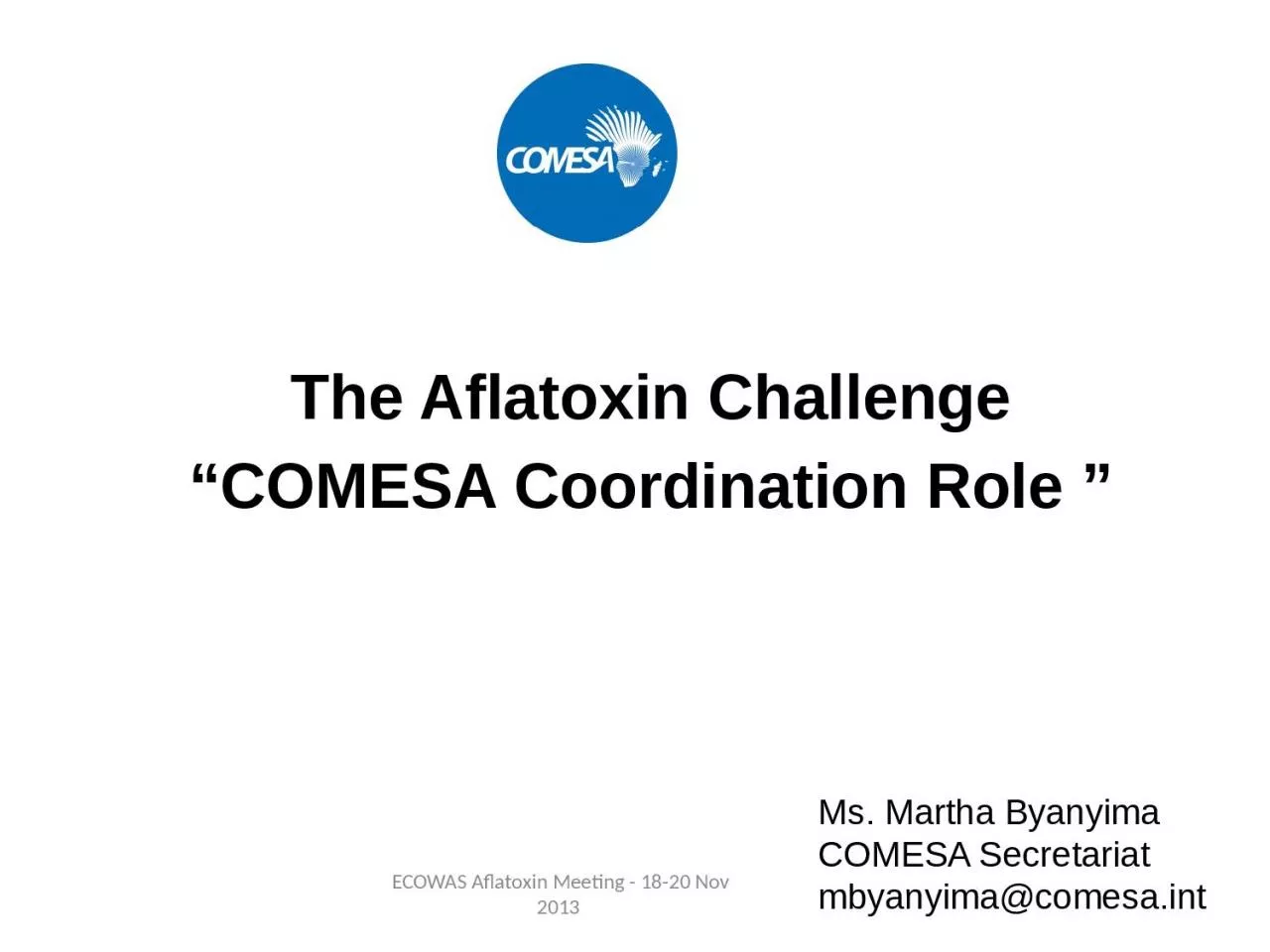

COMESA C oordination R ole Ms Martha Byanyima COMESA Secretariat mbyanyimacomesaint ECOWAS Aflatoxin Meeting 1820 Nov 2013 Overview The Mycotoxin aflatoxin challenge ID: 935628
Download Presentation The PPT/PDF document "The Aflatoxin Challenge" is the property of its rightful owner. Permission is granted to download and print the materials on this web site for personal, non-commercial use only, and to display it on your personal computer provided you do not modify the materials and that you retain all copyright notices contained in the materials. By downloading content from our website, you accept the terms of this agreement.
Slide1
The
Aflatoxin Challenge“COMESA Coordination Role ”
Ms. Martha Byanyima
COMESA Secretariatmbyanyima@comesa.int
ECOWAS Aflatoxin Meeting - 18-20 Nov 2013
Slide2OverviewThe
Mycotoxin/aflatoxin challenge in COMESAChallenges in regional and international tradeRole of COMESA (coordination, setting priorities)The MTSP and the SPS Logical FrameworkThe SPS Unit (Secretariat)The SPS sub Committee (Member States)
The Tripartite SPS /TBT capacity building
programmeSuccess storiesLinkages with PACA
T
he PACA strategic Plan
The COMESA Aflatoxin Meeting (2014) ; sharing experiences with governments, industry and partners (Nacala corridor)Conclusions
ECOWAS Aflatoxin Meeting - 18-20 Nov 2013
Slide3ECOWAS Aflatoxin Meeting - 18-20 Nov 2013 Capacity challenges in the public
and private sector, particularly SMEsInadequate legislation & institutional frameworkVaried sampling and testing protocols ( scientific data for establishing FSO and negotiating equivalence)Varied laboratory competencies, rejection of certificates of analysisThe result in mistrust and restrictions on trade in aflatoxin sensitive foods Maize, peanuts, cassava, and value added products e.g. peanut butter, cassava flour etc
Mycotoxins
/aflatoxins challenge in
COMESA
Slide4Challenges in international tradeECOWAS Aflatoxin Meeting - 18-20 Nov 2013
EU 178/2002 – (a) places legal obligations on food operators (producers, food & feed processors) to ensure food safety, to review and control critical control points for mycotoxin contamination (systems), supplemented by; (b) maximum limits for mycotoxins in food stuffs
Reg
165/2010, total aflatoxin
from 4 to 8 ppb for ready to eat, 10-12 ppb for further processing,
aflatoxin
M1/ 0.05 ppb, (c) OC methods for sampling and analysis of mycotoxins Reg 178/2010
Slide5ECOWAS Aflatoxin Meeting - 18-20 Nov 2013 COUNTRY
Total AflatoxinsCOMMENTSRepublic of South Africa10 - 15 ppbCereals,
peanuts, other nuts
Zambia10 ppb
Cereals,
peanuts, other nuts
Malawi5 ppb
Cereals,
peanuts, other nuts
Zimbabwe
5 ppb
Cereals,
peanuts, other nuts
Kenya
10 ppb
Cereals,
peanuts, other nuts
Egypt
10 ppb
Cereals,
peanuts, other nuts
Slide6Background – MTSP & SPS LFECOWAS Aflatoxin Meeting - 18-20 Nov 2013
MTSP priorities: (a) removing barriers to trade to
consolidate the internal market/FTA (b) building
productive capacity to enhance global
competitiveness and build regional capacity
The MTSP guides the outcomes,
The SPS LF guides intervention logic (what &how)
The SPS Legal Framework
SPS Unit
SPS sub committee
-for
coordination, decision making/setting priorities
Slide7Regional leadership, coordination and collaboration
Private-sector-driven common certification schemes/protocols and standards in
use
Monitoring, surveillance, diagnostic and emergency response systems for priority SPS
risks
Improved decision making using accurate and up-to-date SPS informati
on
Reinforce partnerships:
AU, USAID
, USDA, STDF, CABI/Africa, JIFSAN, IITA,
AATF,TMSA/DFID, AFDB, partner RECs
1.1
NTB reporting
system
1.2 Technical Meetings of the SPS sub committee (annual)
2.1
SPS t
rade facilitation research, pilots,
bilateral
agreements on import protocols
3.1 Fruit fly
surveillance,
plant pests/diseases3.2 aflatoxin sampling and testing protocols – MR mechanism3.3 Pest Risk Analysis4.1 MCDA in Uganda, Ethiopia, Malawi, Zambia and Rwanda Kenya, Zimbabwe are next4.2 MCDA at regional level
The SPS Logical Framework Result Areas
Slide8Objective
– framework to prioritizeMarket access and trade related Investments in the Agric sector
Principle
– All inclusive,
Includes non state actors, PS
Process steps
(
i
)
Stocktaking, review of sector
to establish status with respect to
CAADP targets, investment gaps
(ii) Analysis -
prioritizing and
costing the growth options
focusing on the best returns.
(iii)
Investment Plan
- integrated
investment / operational plan
Objective
– framework to prioritize
SPS capacity building options with a
trade outcomePrinciple - must engage private sector and key stakeholderProcess stepsGathering information, preparing information dossier based on which to establish capacity building options to be considered in the priority setting process.Analysis – costing and ranking the prioritized capacity building options(iii) SPS capacity building options integrated in the CAADP Investment Plan
CAADP Pillar 2 (Market access & trade capacities)
MCDA (Market access)
Slide9The Tripartite SPS work programme
(EAC-COMESA-SADC)ECOWAS Aflatoxin Meeting - 18-20 Nov 2013 Quote: “The tripartite arrangement is the most exciting
trade
and infrastructure development in Africa at the moment, it provides
the foundation of the
Continental
Free Trade Area promoted by the AUC and its partners “Market integration pillar – (i
) a functional FTA free from NTBs, SPS measures inclusive.
Article 25 of the Tripartite FTA Agreement and Annex 10 on SPS; Key provisions/policy instruments and an implementation structure
Joint EAC-COMESA-SADC capacity building
programme
to pilot best practices and approaches along key trade is ongoing to inform interventions
STDF/DFID/COMESA research on SPS and trade facilitation
Slide10ECOWAS Aflatoxin Meeting - 18-20 Nov 2013
Success Story – public/private partnership for harmonizing phytosanitary import requirementsKey activitiesPRAIndustry mitigation through GAPs
andFood Safety
MeasuresDairy, fisheries Identified for action
Slide11Factories that are
HACCP Compliant
Slide12ECOWAS Aflatoxin Meeting - 18-20 Nov 2013
Success story: the pelagic fish industry(Dagaa/Kenya, Kapenta/Zambia,
Mukene/Uganda)
10 Years ago
Poor
harvesting methodsInadequate food safety standardsPoor handling practices
Slide13Modern harvesting
technologyImproved handling and dryingImproved food safety standards
Today :
Slide14Success story
: Domestic and Regional Markets expanding thru food safety/quality management andValue addition
Slide15ConclusionsEffective coordination mechanism at tripartite level (EAC-COMESA-SADC)
Legally binding decisionsTripartite structure to enable harmonization, equivalence and mutual recognitionTripartite structure to enable effective capacity building including regulatory reformsPartners on board include DFID, AFDB, STDF and partnersChallenge is aligning partners with regional/tripartite integration prioritiesHow does PACA or GFSI support the tripartite agenda ?Are there lessons for ECOWAS and other RECs ?ECOWAS Aflatoxin Meeting - 18-20 Nov 2013